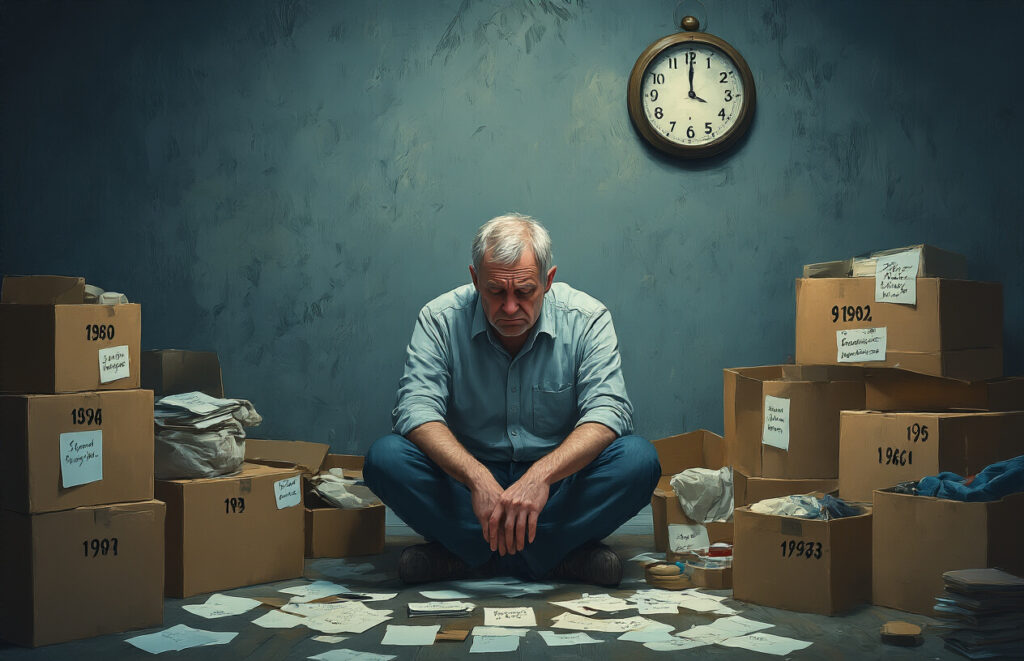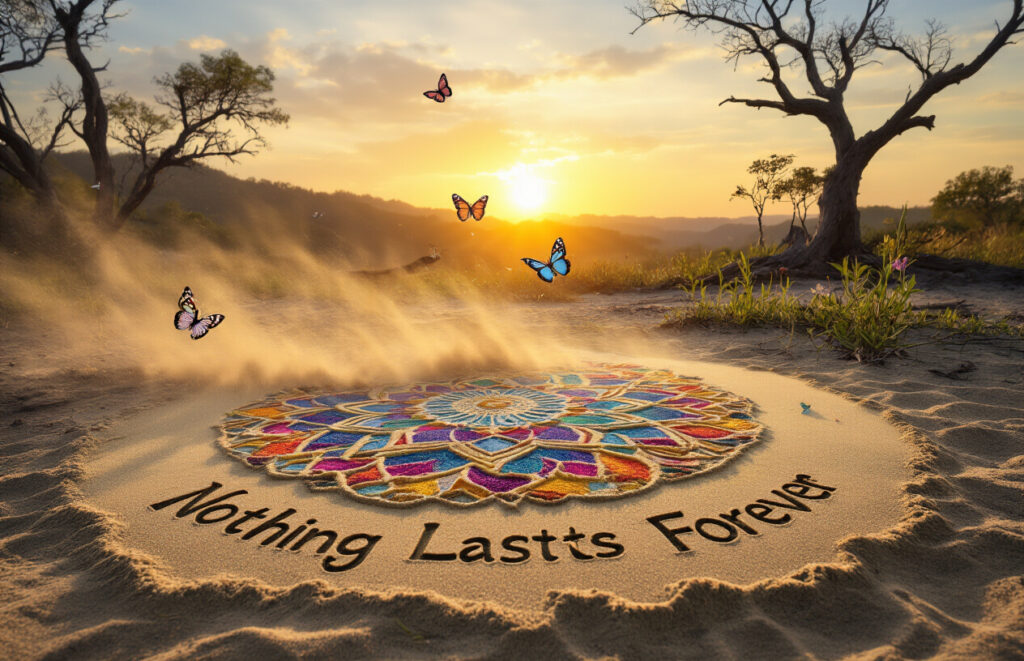Table of Contents
A SHORT AUDIO OF THE POST
Introduction
In fact, it’s a good thing that everything in life has an expiration date. Anyone who feels stuck in relationships, a job, or possessions that have outlived their usefulness should read this guide.
We’ll look at how letting go clears your mind, why impermanence gives meaning, and what various cultures have to say about accepting inevitable endings.
You’ll soon learn:
How a healthy human experience is reflected in the natural cycle of impermanence
Why the burden of “forever” causes needless mental strain
How our lives often have the greatest meaning when we have brief connections
The Natural Cycle of Impermanence

How growth and evolution are fuelled by impermanence
Nothing endures forever. And I’m grateful for that.
Consider this: we would still be single-celled creatures adrift in primordial soup if nothing changed. Impermanence is the force behind all growth, not just a philosophical idea.
Species either adapt to new challenges or go extinct. Couldn’t the dinosaurs manage a meteor? They have vanished, allowing mammals to flourish. Every seven to ten years, your body replaces the majority of its cells. You’ve undergone a significant transformation in the last decade.
And that’s truly incredible.
Examples of necessary endings in nature
There is no “forever” in nature. Seasons, cycles, and dramatic conclusions are all part of it.
Although a forest fire may appear destructive, it actually removes deadwood and activates some seeds that require extreme heat to sprout.
Cherry blossoms enchant us because they are only around for a few days. Instead of apologising for falling, autumn leaves produce the compost that supports growth the following spring.
In nature, death is not a flaw in the design. It’s a feature.
The beauty of fleeting moments
The sunset is lovely because it signifies the end of the day.
Because you couldn’t stay there indefinitely, that vacation felt magical. Because it was a one-night event, the concert was unique. If the temperature never dropped, even the most perfect cup of coffee would lose its appeal.
We cherish the ephemeral. Value is created by scarcity. Wonder would be killed by permanence.
Suffering arises as a result of resistance to change.
Fighting impermanence is like fighting gravity; you will always lose and suffer consequences.
We cause our own suffering when we hold onto identities, careers, or relationships that are past their natural end. According to Buddhism, the root cause of suffering is attachment—the desire for things to remain constant in a world that is predisposed to change.
Sand slides through your fingers more quickly if you hold on to it tightly.
Individuals who accept endings don’t experience less change than others; they simply experience less of the inevitable change.
.
The Psychological Burden of Permanence

How anxiety is caused by “forever” expectations
Have you ever experienced a sudden tightness in your chest when someone says, “Let’s be friends forever”? That’s not out of the ordinary. Our brains were not made to think “forever.”
A psychological pressure cooker is created the instant we give permanence to anything, including homes, jobs, and relationships. We begin to overthink things. We are concerned about preserving ideal circumstances forever. We worry about possible failures.
Consider the phrase “‘Til death do us part” in marriage vows. Indeed, it’s a lovely sentiment. But if you think about it too much, it’s also terrifying. What if we change? What if things change? What if I am unable to fulfil that commitment?
In addition to causing anxiety, these demands for unwavering consistency are essentially impractical. In nature, nothing endures forever. Why should our living arrangements, occupations, or relationships?
Accepting endings gives you freedom.
A wonderful thing occurs when you accept that everything has a natural end: relief.
Embracing impermanence is liberating, not depressing. You make decisions based on present value rather than unending commitment when you accept that your current position may not be your forever one.
Relationships also change. Rather than frantically holding on to relationships that are no longer relevant, you can recognise the value they added to your life and move on without feeling guilty.
Permission to change is the most profound form of freedom. You can allow yourself to grow without feeling like you’ve broken some cosmic contract when you stop expecting permanence from yourself.
How impermanence fosters appreciation for the here and now
There’s nothing like scarcity to help you focus.
We pay attention when we realise something won’t last forever. We relish. We get more involved.
Think about taking a trip. The fact that those last days are coming to an end often makes them feel the most vivid. You pick up on details that you might have missed before, like the specific shade of the sunset or the texture of the sand.
Regarding life stages, the same idea holds true. Parents who recognise the transient nature of childhood are more likely to be present with their children. They are aware that these particular moments will never return.
Reminding ourselves that “this too shall pass” makes even the most trying times more tolerable. Nothing that is good endures forever, but nothing that is painful does either.
The reality? Our awareness of transience is directly related to our ability to appreciate. We cherish things that we are aware we cannot keep.
Relationships and Finite Connections

Why certain relationships are intended to be seasonal
Not everyone who enters your life is intended to be there for the long haul. It’s actually ideal when some characters in your story are only there for a short time.
Consider it. When you’re adjusting to parenthood, you might not need your college flatmate who got you through finals week. When your careers diverge, your first-job coworker may disappear.
There is nothing wrong with these seasonal relationships. They are whole narratives with logical conclusions.
Do you recall how you used to hang out with kids from the neighbourhood simply because they lived close by? As adults, we occasionally attempt to apply the same reasoning, holding onto relationships merely because they were once in place.
How endings make room for fresh starts
You have a finite amount of social energy. You don’t have time for either.
Every relationship you have requires emotional energy. You’re effectively keeping seats at a table that could accommodate new visitors when you hold onto relationships that have naturally reached the end of their usefulness.
Divorcing a friend or partner creates space for:
Individuals who support your current self rather than your past self
Relationships that energise you instead of deplete you
Relationships that provide constructive challenges
The voids left by endings are possibilities rather than merely voids..
The risk of imposing permanent relationships
All of us have done it. continued to text someone out of duty. planned those progressively uncomfortable coffee dates. kept up online relationships with people we wouldn’t normally approach in person.
Relationships that are forced past their natural end result in:
Resentment that ruins pleasant memories
Fear of encounters that ought to be enjoyable
False relationships that obstruct real ones
In addition to hurting you, relationships maintained on life support keep both parties from discovering connections that truly reflect who they have become.
Learning and development via changes in relationships
Every breakup is a graduation rather than a failure.
Even if you no longer climb together, the friend who first introduced you to rock climbing fulfilled their role. You will be able to use the skills that your partner taught you to improve your communication.
Humans are educators. Some finish doctoral programs, while others teach courses for semesters. Both are worthwhile.
When a relationship changes, consider this:
What did I learn from this connection?
How has this individual influenced who I am?
Which patterns should I continue or stop?
How to know when to let go
When a relationship is over, your body senses it before your mind does.
Be mindful of:
The fear you have before you see them
Your subsequent feelings (drained vs. energised)
The proportion of duty to sincere desire
Regardless of whether you’re relating to their current or past selves
If you’re acting or presenting yourself in a genuine way
Dramatic confrontations are not necessary for healthy endings. There are moments when they are simply mutual fades interspersed with friendly check-ins. At other times, they require explicit dialogue.
Honouring the completion of a relationship rather than dragging it into a zombie afterlife is the most considerate thing you can do for it.
Material Possessions and Planned Obsolescence

The effects of “forever” products on the environment
Are those “buy it for life” products familiar to you? As it happens, they’re not as great as they seem. Businesses that produce indestructible items frequently use environmentally harmful materials, such as metals that need destructive mining or plastics that will outlast your great-grandchildren.
The truth? A product that decomposes and returns to the earth isn’t always superior to one that has been in your garage for thirty years.
Consider electronics. For more than 400 years, that “indestructible” phone case composed of industrial-grade polymers will remain in use. In the meantime, there are biodegradable substitutes that work just as well for the two to three years you’ll really own that phone.
How attachment to objects leads to stress and clutter
Have you ever entered your house and felt a sense of weight? That is your burden.
We keep things because “I paid good money for this” or “they might be useful someday.” But every object requires something of us—space, upkeep, choices, and feelings.
Mental clutter arises from physical clutter. Whether you are aware of it or not, your brain must process every object in your environment. Cortisol levels are higher in people with cluttered homes, according to studies.
Your inability to part with that bread maker you used just once in 2017 is causing your stress hormone to go haywire.
The simple method of short-term ownership
Being minimalist doesn’t mean having nothing. You should only own what is useful to you at the moment.
Astute minimalists view belongings as transitory guests rather than long-term residents. “Does this add value to my life today?” they inquire. Five years ago, no. It hasn’t happened yet, but it might happen in the future. Today.
This method changes the way you interact with objects. When quality is needed, you purchase it, use it to the fullest while it serves you, and then, guilt-free, give it away when its function is complete.
Comparable to a good book, your possessions are meant to be read, appreciated, and then given to someone else in need.
Embracing impermanence to promote sustainable consumption
The item that biodegrades after its useful life is over is the most sustainable, not the one that lasts forever.
We make different decisions when we accept the transient nature of our belongings:
We choose items made to be disassembled and recycled.
Repair and upkeep are more important to us than replacement.
By borrowing, renting, and sharing, we engage in circular economies.
Demand for more than just long-lasting products is generated by this way of thinking. In response, businesses design with the full lifecycle—from end-of-life disposal to ethical sourcing—in mind.
Accepting cheap, disposable junk is not the same as embracing impermanence. It entails acknowledging that everything has a lifespan and purposefully creating that lifespan.
.
Cultural Perspectives on Impermanence

Eastern ideas about the beauty of fleeting
Have you ever noticed that Japan celebrates cherry blossoms just because they don’t last? Finding beauty in things’ transient nature is the essence of wabi-sabi.
Impermanence is embraced rather than feared in Eastern philosophy. The Buddhist idea of anicca, or impermanence, is not merely philosophical jargon; it is also common sense, which states that holding onto things that are transient only leads to suffering.
Consider it. The Japanese celebrate the end of things with parties rather than simply accepting it! Viewings of cherry blossoms honour beauty because it is fleeting. Everyone is reminded by the ephemeral pink blossoms: “This moment? The very fact that it is transient makes it valuable.
Western opposition to death and endings
Endings are strange to the Westerners. Our obsessions are “till death do us part,” “eternal love,” and “immortalised in history.”
Death? We hardly discuss it. We can’t handle the D-word, so we use euphemisms like “passed away” or “no longer with us.” Denying the inevitable—life extension, anti-aging creams, and digital legacies—is central to our entire culture.
The issue? Anxiety is brought on by this resistance. Normal endings feel like failures when everything good must last forever. A partnership that fulfilled its function and ended? It must be a catastrophe. A redirected career? There must be a crisis.
How various cultures commemorate endings
When something ends, some cultures do in fact throw parties—and I’m not referring to celebrations for divorce.
Día de los Muertos in Mexico transforms sorrow into a vibrant celebration. Families erect altars, eat together, and even physically call deceased family members to the celebration. Death isn’t hidden away; sugar skulls and marigolds adorn it.
Cremation rituals in Hinduism are associated with liberation as well as mourning. The soul’s liberation from the cycle of rebirth is symbolised by the burning of the body.
Northern Europeans think differently. Elderly people are encouraged to declutter before they pass away by the Danish concept of “oprydning”—not as a morbid task, but as a way to give to loved ones and take stock of their life’s journey.
Embracing Necessary Endings

Useful techniques for letting go
All of us hold onto things far longer than is healthy. That holey old t-shirt? It’s still in your drawer. That partnership that ended years ago? I’m still working to fix it.
The fact is that letting go is a skill you develop over time.
Begin modestly. Every week, choose one tangible item that no longer fulfils your needs. Experience the lightness that follows its departure.
Try writing a farewell letter for more significant things, like jobs, relationships, or dreams that are no longer yours. Sending it is not required. Writing things down facilitates your brain’s processing of the conclusion.
For grief, set a timer. Indeed, it is. Give yourself permission to feel awful for twenty minutes. Engage in physical activity when the timer goes off, such as dancing, walking, or organizing a drawer.
Discovering purpose in the fleeting phases of life
Perhaps 15 minutes is how long the most stunning sunset lasts. Does its briefness diminish its significance?
Every stage of your life, even the difficult ones, has something special to offer. College teaches you to be independent. You see what you don’t want in that awful job. You need to see patterns, even in failed relationships.
The key is presence. When you’re always holding on to the past chapter or hoping for the next one, you can’t find meaning.
Try this: At day’s end, ask yourself, “What did today teach me that only today could?”
Developing constructive farewells and transitions
Our endings are awful. We abruptly quit our jobs, ghost people, or, worst of all, allow relationships to deteriorate into awkward emptiness.
Better farewells lead to better starts.
When something important comes to an end:
Describe the meaning it held for you.
Recognise the steps you’re taking.
Make a symbolic act, such as burning letters, giving things back, or planting a tree.
Establish rituals for life transitions. Celebrate your bravery by throwing a “divorce party.” Organise a “career pivot dinner” where friends bring items that represent your new direction.
The conundrum: significant influence without durability
Although nothing lasts forever, everything is extremely important.
Consider how a friendly remark to a complete stranger could transform their entire day. It will never be known to you. Your friend’s viewpoint may change for years as a result of the book you recommended.
Permanence is not necessary for impact. The sand mandala monks teach us that there is beauty and significance in the process as well as the final product by spending days creating elaborate artwork and then ceremoniously destroying it.
It’s the same in your life. You’ll never be able to fully track the ways your influence spreads. It’s likely that the mentor who transformed your life is unaware of the extent of the change.
Making meaning and letting go of the need for it to endure forever is the greatest freedom.
My Zone

My grandmother told me a story before bed that made me realize for the first time that everything in life has a shelf life. She had a wonderful gift for teaching by telling simple stories, and this story has stuck with me all my life.
She told of a bright thinker who aspired to immortality because he thought it was the greatest gift. He eventually discovered a mysterious forest with a cave inhabited by small, 500-year-old creatures.
Indeed, they had defeated death, but not without a cost. They couldn’t go outside because their bodies had gotten weaker and smaller with age. What they considered a boon had turned into a jail.
“Child, endings aren’t punishments; they’re nature’s way of keeping life beautiful,” my grandmother would say, pausing to look into my eyes. I only partially understood at the time.
However, I have witnessed her reality over the years—stages, seasons, and even tragedies all come and go to create room for the next phase.
I learnt from her story that shelf life is about the grace of letting go so that life can continue to renew itself, not about loss.
Frequently Asked Questions
1.. Does accepting impermanence entail abandoning promises?
Absolutely not. Although commitment is important, it functions best when it is based on the here and now rather than an impractical “forever” promise. Simply put, accepting impermanence entails being receptive to the idea that things could change and that’s okay.
2.How can I tell when a relationship or job is time to end?
Be mindful of your emotional cues. It might be time to let go if fear consumes you more than joy, if you feel exhausted rather than energised, or if you’re clinging to obligation or guilt instead of real connection.
3. The idea that nothing endures forever is depressing, isn’t it?
It’s freeing, but it can also be. Understanding that things are fleeting motivates you to enjoy them to the fullest while they are available. Knowing that change is a natural part of life’s rhythm also makes it easier to deal with loss..
4. How can one begin to accept impermanence in day-to-day existence?
Begin modestly. Give up something you no longer need, or be thankful for a moment as it comes, without wishing it would last longer. Gradually strengthen the “letting go” muscle.
5. When I know something is coming to an end, how can I remain in the moment?
Instead of asking yourself, “How long will this last?” ask yourself, “What’s here for me right now?” Use all of your senses, pay attention to the little things, and approach the situation as though it were already the beginning of a treasured memory.
Final Thoughts
Life is a sequence of chapters, each with its own lessons, pleasures, and farewells; it is not intended to be an uninterrupted line. The realisation that “nothing lasts forever” is an invitation to live life to the fullest rather than a condemnation.
Impermanence challenges us to let go of things that no longer serve us, respect those that did, and bravely face the future. It serves as a reminder that endings are not failures but rather the seeds of new beginnings.
The most beautiful lives are those that dance completely in the present, knowing that the music will eventually fade—and that’s what makes it worth listening to in the first place—rather than those that cling to permanence.




